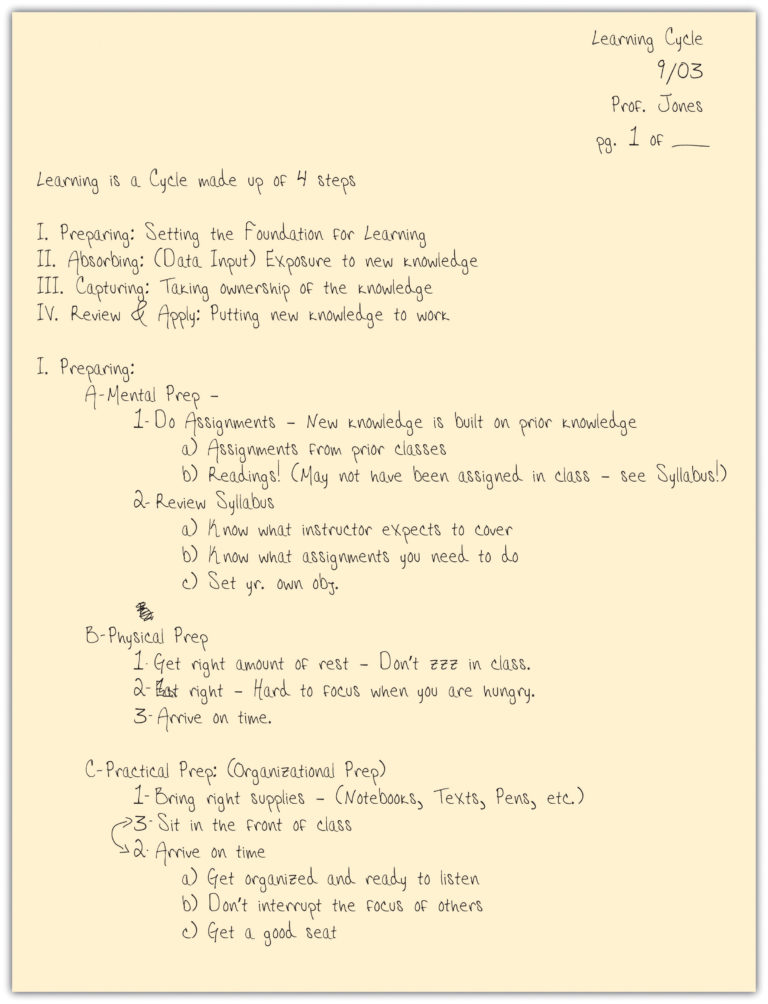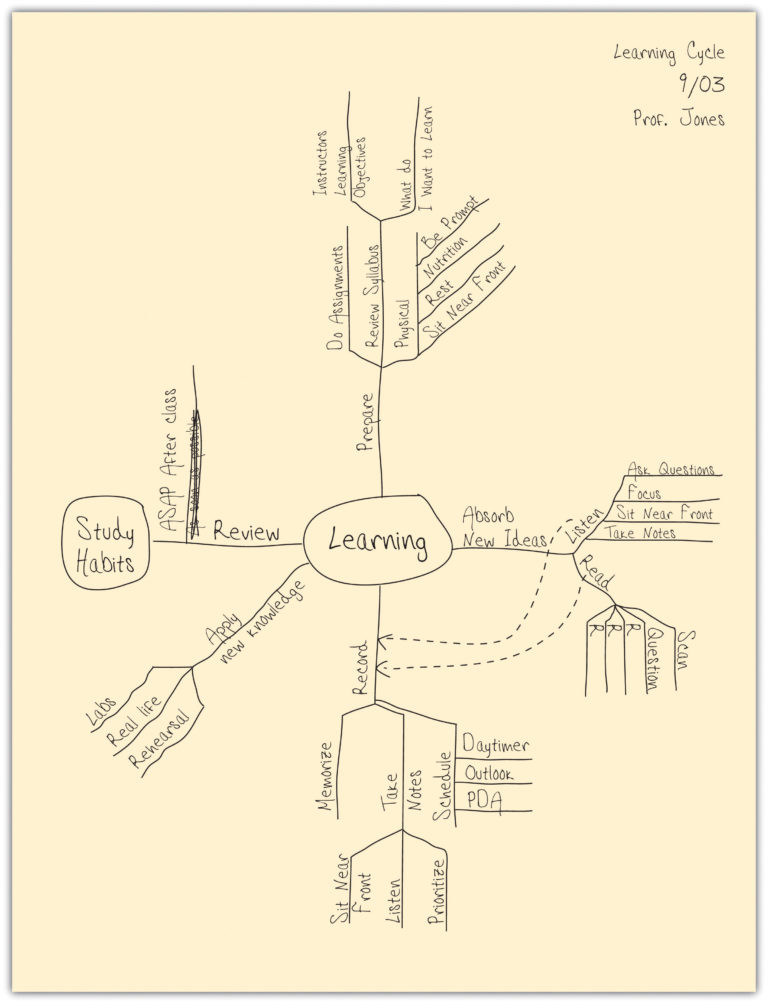29 Note-Taking

learning objectives
In this chapter you will:
- Get an understanding of why we take notes
- Understand different note-taking systems and how they connect to different learning styles
- Identify and evaluate the note-taking methods/systems
Student Spotlight
This video introduces you to note taking. With this video, you will be able to answer the following questions: How do you decide what classes you need to take notes? How do you know that your notes are effective?
Self-reflection
Pre-Activity: As you begin thinking about your note-taking, self-reflect. Ask yourself the following questions, and write down the answers so that you may look back on them later.
- Identification: What note-taking systems do you currently use (for instance, in class or at work)?
- Implementation: When do you use these systems?
- Effectiveness: How effective are these strategies? How do you know?
Now that you have thought about the note-taking strategies you use, read about different note-taking systems below.
Note-Taking Systems, Methods and Study Guides
The following is a chart with a brief explanation of the main note-taking systems that are described in more depth later in this section.
|
Method |
Description |
When to Use |
|
Lists |
A sequential listing of ideas as they are presented. Lists may be short phrases or complete paragraphs describing ideas in more detail. |
This method is what most students use as a fallback if they haven’t learned other methods. This method typically requires a lot of writing, and you may find that you are not keeping up with the professor. It is not easy for students to prioritize ideas in this method. |
|
Outlines |
The outline method places most important ideas along the left margin, which are numbered with roman numerals. Supporting ideas to these main concepts are indented and are noted with capital letters. Under each of these ideas, further detail can be added, designated with an Arabic number, a lowercase letter, and so forth. |
A good method to use when material presented by the instructor is well organized. Easy to use when taking notes on your computer. |
|
Concept Maps |
When designing a concept map, place a central idea in the center of the page and then add lines and new circles in the page for new ideas. Use arrows and lines to connect the various ideas. |
Great method to show relationships among ideas. Also good if the instructor tends to hop from one idea to another and back. |
|
Cornell Method |
The Cornell method uses a two-column approach. The left column takes up no more than a third of the page and is often referred to as the “cue” or “recall” column. The right column (about two-thirds of the page) is used for taking notes using any of the methods described above or a combination of them. After class or completing the reading, review your notes and write the key ideas and concepts or questions in the left column. You may also include a summary box at the bottom of the page. |
The Cornell method can include any of the methods above and provides a useful format for calling out key concepts, prioritizing ideas, and organizing review work. Most colleges recommend using some form of the Cornell method. |
The List Method

The list method is usually not the best choice because it is focused exclusively on capturing as much of what the instructor says as possible, not on processing the information. Most students who have not learned effective study skills use this method. Even if you are skilled in some form of shorthand, you should probably also learn one of the other methods described here because they are all better at helping you process and remember the material. You may want to take notes in class using the list method, and then transcribe your notes to an outline or concept map after class as a part of your review process. It is always important to review your notes as soon as possible after class and write a summary of the class in your own words.
The Outline Method

The advantage of the outline method is that it allows you to prioritize the material. Key ideas are written to the left of the page, subordinate ideas are then indented, and details of the subordinate ideas can be indented further. To further organize your ideas, you can use the typical outlining numbering scheme (starting with roman numerals for key ideas, moving to capital letters on the first subordinate level, Arabic numbers for the next level, and lowercase letters following.) At first you may have trouble identifying when the instructor moves from one idea to another. This takes practice and experience with each instructor, so don’t give up! In the early stages you should use your syllabus to determine what key ideas the instructor plans to present. Your reading assignments before class can also give you guidance in identifying the key ideas.
If you’re using your laptop computer for taking notes, a basic word processing application (like Microsoft Word or Google Docs) is very effective. Format your document by selecting the outline format from the format bullets menu. Use the increase or decrease indent buttons to navigate the level of importance you want to give each item. The software will take care of the numbering for you!
After class be sure to review your notes and then summarize the class in one or two short paragraphs using your own words. This summary will significantly affect your recall and will help you prepare for the next class.
The Concept Map Method

Concept mapping is a very graphic method of note-taking that is especially good at capturing the relationships among ideas. Concept maps harness your visual sense to understand complex material “at a glance.” They also give you the flexibility to move from one idea to another and back easily (so they are helpful if your instructor moves freely through the material).
To develop a concept map, start by using your syllabus to rank the ideas you will listen to by level of detail (from high-level or abstract ideas to detailed facts). Select an overriding idea (high level or abstract) from the instructor’s lecture and place it in a circle in the middle of the page. Then create branches off that circle to record the more detailed information, creating additional limbs as you need them. Arrange the branches with others that interrelate closely. When a new high-level idea is presented, create a new circle with its own branches. Link together related circles or concepts by using arrows and symbols to capture the relationship between ideas. For example, an arrow may be used to illustrate cause or effect, a double-pointed arrow to illustrate dependence, or a dotted arrow to illustrate impact or effect.
As with all note-taking methods, you should summarize the chart in one or two paragraphs of your own words after class.
The Cornell Method

The Cornell method was developed in the 1950s by Professor Walter Pauk at Cornell University. It is recommended by most colleges because of its usefulness and flexibility. This method is simple to use for capturing notes, is helpful for defining priorities, and is a great study tool.
The Cornell method follows a very specific format that consists of four boxes: a header, two columns, and a footer. The header is a small box across the top of the page. In it you write identification information like the course name and the date of the class. Underneath the header are two columns: a narrow one on the left (no more than one-third of the page) and a wide one on the right. The wide column, called the “notes” column, takes up most of the page and is used to capture your notes using any of the methods outlined earlier. The left column, known as the “cue” or “recall” column, is used to jot down main ideas, keywords, questions, clarifications, and other notes. It should be used both during the class and when reviewing your notes after class. Finally, use the box in the footer to write a summary of the class in your own words to help you make sense of your notes in the future and serve as a valuable tool to aid with recall and studying.
A Closer Look
Now that you’ve learned about different note-taking systems, let’s try them out. Over the next two weeks, use at least three different note-taking systems and document your experience in the chart below:
|
Note-Taking System/ Method |
Date of Use and Subject (Lecture, Reading, or Other; Discipline) |
What worked well? |
What was challenging? |
Why did you use this system/method? Did it link to an assessment? |
What was the outcome of the assessment? |
|
List |
|
|
|
|
|
|
Outline |
|
|
|
|
|
|
Concept Map |
|
|
|
|
|
|
Cornell Method |
|
|
|
|
|
|
Other |
|
|
|
|
|
After two weeks, review your responses. Which systems/methods worked well for you? Are there any revisions you will make going forward? If so, what are these and why are you making these revisions?
References, licenses, and attributions
California Polytechnic State University Academic Skills Center (n.d.). Writing and learning initiatives. California Polytechnic State University. Retrieved August 10, 2022 from https://asc.calpoly.edu/ssl/listening#notes
Dartmouth Academic Skills Center (n.d.). Notetaking. Dartmouth College. Retrieved August 10, 2022 from https://students.dartmouth.edu/academic-skills/learning-resources/learning-strategies/notetaking
LaGuardia Community College Library (2022, October 3). Student success – first year, any year: Note taking. LaGuardia Community College. https://guides.laguardia.edu/c.php?g=454969&p=3283690
Northwestern Libraries (2021, September 14). First-Year Seminar template: Tips for reading and note-taking. Northwestern University. https://libguides.northwestern.edu/c.php?g=1081362&p=7880996
Nowak, Paul (2015, March 15). Note-taking strategies for students. Iris Reading. https://youtu.be/K1Hk7TgaRxE
University of Minnesota (2015). Chapter 4.4 Got notes? In College Success. https://doi.org/10.24926/8668.0301. CC BY-NC-SA 4.0 except where otherwise noted.
Westchester Community College (2022). Note-Taking. In Westchester community college first-year seminar. Retrieved August 10, 2022 from https://courses.lumenlearning.com/suny-wcc-collegesuccess2/chapter/active-learning/. CC BY 4.0
